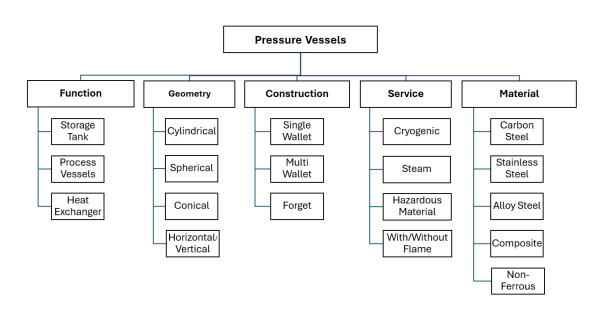
Submission to VIJ 2024-09-17
Keywords
- "green" economy, sustainable development, economic systems, energy sources.
Copyright (c) 2024 Mehmet Ali Acar, Can Gönenli, Mustafa Berkant Selek

This work is licensed under a Creative Commons Attribution 4.0 International License.
Abstract
Pressure vessels are widely used in many areas. Ensuring the safe operation of pressure vessels is particularly important, especially in residential and industrial applications. Errors made during the use of pressure vessels or mistakes during manufacturing and design can lead to significant accidents, resulting in loss of life and property. With the increase in industrialization and energy production, significant advancements have been made in the field of pressure vessels. These vessels are used in various applications, such as heat exchangers in domestic heating systems, and in industrial facilities for the production of steam, superheated oil, and hot water needed for production and separation processes. The advancement of technology and the updating of design and computer aided design programs enable more accurate results in new design and analysis, allowing to produce more reliable and safer materials. To minimize occupational accidents, necessary precautions must be taken in advance. The development of pressure vessels in terms of occupational safety has been ongoing from past to present and is being further enhanced through ongoing studies. In our study, pressure and stress analysis were conducted using the finite element method on ANSYS. Mechanical analyses were repeated for three different thicknesses and three different material types. The purpose of the mechanical analysis was to examine the effect of the thicknesses and different material types on pressure vessels in terms of stress, deformation, and strain.
References
- M. Azeem, et al., “Influence of winding angles on hoop stress in composite pressure vessels: Finite element analysis”, Results in Engineering, 23 (2024), 101667.
- J. Monteiro, S. Y. Nayak, K. A. Mathias, and N. Patil, “Effect of fiber orientation and reinforcements on the performance of composite pressure vessel using finite element analysis, Cogent Engineering, 11(1) (2024).
- I. Gophane, N. Dharashivkar, P. Mulik, and P. Patil, “Theoretical and finite element analysis of pressure vessel”, Indian Journal of Science and Technology, 17(12) (2024), 1148-1158.
- G. W. Watts, and H. A. Lang, “The stresses in a pressure vessel with hemispherical head”, Journal of Fluids Engineering, 75(1) (1953), 83-89.
- P. P. Radkowski, R. M. Davis, and M. R. Bolduc, “A numerical analysis of the equations of thin shells of revolution”, American Rocket Society, 32(1) (1962).
- M. Kandaz, “Computer aided design and structural analysis of pressure vessels”, M.S., Middle East Technical University, (2006).
- F. Tinis, and F. Bazman, “Silindirik ince cidarlı basınçlı kolonların artan deprem yüklerine karşı takviyelendirilmesi”, TMMOB Makina Mühendisleri Odası Konya Şubesi III. Makina Tasarımı ve İmalat Teknolojileri Kongresi, (2005).
- M. F. Opačić, A. Sedmak, G. Bakić, N. Milošević, and N. i Milovanović,, “Risk assessment of pressure vessels by using fracture mechanics and advanced ultrasonic testing”, Tehnički vjesnik, 31(1) (2024), 118-124.
- J. Jegatheesan, Z. Zakaria, “Stress analysis on pressure vessel”, Environment & Ecosystem Science, 2(2) (2018), 53-57.
- TS 2025, “General Rules for Operation Inspection and Maintenance of Steam Boilers”, Turkish Standards Institution, 2021.
- TS 430, “Sectional Cast Iron Boilers”, Turkish Standards Institution, 1984.
- TS EN 303-1, “Heating Boilers, Turkish Standards Institution, 2017.
- M. Akpolat, “Türkiye ve Avrupa’da kazanların güvenli çalışma ve periyodik control kriterleri, Ankara, 2014.
- İ. Sancaklı, “Basınçlı kap konstrüksiyonlarına etki eden parametrelerin incelenmesi ve tasarımı, İstanbul, 2017.
- BPVC, “Boiler and Pressure Vessel Code”, ASME, 2011.
- E. Koç, İ. Keleş, and K. Yıldızlı, “İnce cidarlı silindirde gerilme ve şekil değiştirme analizi deneyi”, Ondokuz Mayıs Üniversitesi Makine Mühendisliği Bölümü, 2012.
- S. Chattopadhyay, “Pressure vessels design and practice”, CRC Press, 2004.
